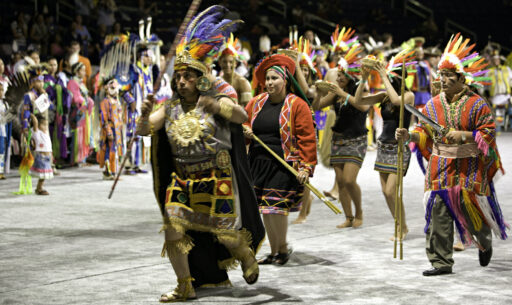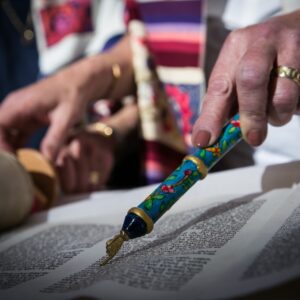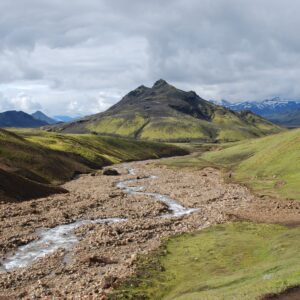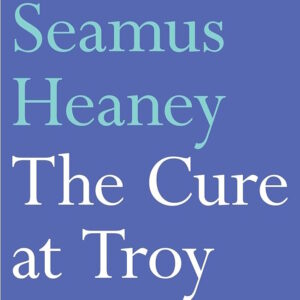I was briefly in Santa Fe, New Mexico last month, where a good friend insisted we pay a visit to the Monroe Gallery of Photography. The storefront space displays images from a century of photojournalism: iconic pictures from the US civil rights era, quirky takes on famous writers, moody landscapes, and candid moments in the lives of ordinary people. Among the more recent images was a 2020 color photo of a nineteen-year-old native of Ohkay Owingeh Pueblo dancing on a stone platform. Upon closer inspection, that platform turned out to be an empty plinth that once supported an equestrian statue of a Spanish conquistador, Juan de Oñate.
As a work of art, the photo has a dark, breathtaking beauty: the ecstatic dancer captured midstep against menacing clouds, taught power lines, and gray-edged fabric (a flag? a fence?) serving as framing diagonals, the plinth and bronze plaque defaced with blood-red handprints. It’s particularly moving to me because of my years of work in and advocacy for Native American child health and my long interest in the history of indigenous peoples in what is now the American Southwest. The background story for this picture, though long and sad, is well worth telling.
In 1598, Oñate, a Basque-Spanish adventurer, led 129 men “of fighting age” along with their families and livestock north from the Viceroyalty of New Spain (modern day Mexico and Central America) to establish a colony in Nuevo Mexico. Armed Spanish explorers had wandered north of El Paso del Norte before, but Oñate’s followers came to stay, settling along the Rio Grande valley, establishing missions in Pueblo villages. Relations with indigenous peoples quickly soured. In December 1598, Spanish soldiers raided Acoma Pueblo, demanding food and shelter. The Acoma drove them off, killing several Spaniards. A month later, Oñate’s troops responded in force, blasting through the pueblo’s defensive walls with artillery fire. Eight hundred Indians died in the assault, with an additional five hundred taken captive. Under Oñate’s orders, male prisoners over twenty-five had one foot cut off and were sentenced to twenty years involuntary service. Women and younger men were enslaved. Children under twelve were sent to Spanish families and schools to receive “a Christian upbringing.” Oñate was later tried, convicted, and exiled by order of the Spanish Viceroy for cruelty to natives and colonists, but his atrocities left a lasting impression on the region’s indigenous peoples.
After decades of oppression, the natives rose against the Spanish colonizers in the 1680 Pueblo Revolt. Meticulously planned and coordinated by Po’Pay, an Ohkay Owingeh leader, the uprising killed Franciscan missionaries, Spanish soldiers, and settlers in simultaneous mutinies from Taos to the Hopi mesas. The victorious Puebloans then shadowed what was left of the Spanish occupation as it retreated south of the Rio Grande. The Spanish returned in full force in 1692 under Don Diego de Vargas, though they eventually eased some of their demands on the Puebloan peoples in exchange for material cooperation against Navajo and Apache raids. For the next 150 years, an uneasy hierarchy prevailed, punctuated by eruptions of violence.
Then, in 1846, a year after Texas was admitted to the Union as a slaveholding state, the U.S. invaded the now independent county of Mexico. In fulfilling America’s “Manifest Destiny,” and whetting the South’s appetite to extend chattel slavery westward, the U.S. forcibly annexed over half of Mexico’s territory, “crossing the border” over a predominantly indigenous and mestizo population. American opposition to what then lieutenant Ulysses S. Grant called a “wicked” war focused on two concerns: the likely addition of slaveholding states and the demographic “peril” of adding too many brown, Spanish speaking Catholics to an overwhelmingly white Anglo-Saxon Protestant country. Once the war was underway, however, most opponents dutifully rallied behind the troops.
As for the residents of New Mexico, any hope that their new conquerors would rule with a lighter touch was quickly dashed. In January 1847, a joint Hispano-Puebloan rebellion arose over concerns that the new government would not respect longstanding land claims established under Mexican rule. Several Americans, including the provisional governor, were killed. The so-called Taos Revolt was quickly and brutally suppressed by the U.S. army. When insurgents and civilians took refuge in Taos Pueblo’s Catholic church, U.S. artillery breached its walls, then directed short-range cannon fire into the church interior, killing more than 150 people. Eventually, at least twenty-eight New Mexicans tried in military courts were convicted and executed for murder and treason against a government they had neither chosen nor pledged allegiance to.
The complexity of this history can be glimpsed in the two figures representing New Mexico in the U.S. Capitol’s Statuary Hall. One is of Po’Pay, leader of the 1680 Pueblo Revolt. The second depicts Dionisio “Dennis” Chávez, the first Hispano-American elected to a full term as U.S. Senator. The two men, born 250 years apart into the lower rungs of the America’s racialized caste system, found very different means toward a similar goal: upending the status quo. One of the ways that system endures, however, is by setting otherwise natural allies against one another, as if mestizaje—the centuries-long mixing of indigenous and Iberian immigrant bloodlines—never happened. This isn’t a ploy unique to the U.S. or an abstract problem for me. My adopted daughter’s Guatemalan birth certificate reads “No Indio,” a political claim belied by her café-au-lait skin; long, straight black hair; and chiseled facial structure. My daughter embodies mestizaje.
Recently, however, questions have arisen as to what events and whose heroes deserve public commemoration. Rarely, if ever, are all parties invited to the planning table, and quarrels break out along old fracture lines. In northern New Mexico, annual Fiestas de Santa Fe celebrated Spanish colonial culture with much excitement and pageantry, including visits by conquistador reenactors to local schools. Indigenous children were understandably less enthused. In 1997, nearly four hundred years after Oñate’s colonizing expedition, members of a protest group calling themselves “Friends of Acoma” sawed the right foot off a recently erected equestrian statue of Oñate in Rio Arriba County, New Mexico. What some Puebloans saw as poetic justice was viewed as an outrage by some Hispano-Americans.
Though a bronze foot was soon recast and welded to the statue, protesters returned to paint the foot red and cover the concrete base with graffiti. In 2020, as monuments to Confederate officers in southeastern states were warehoused or toppled, county officials hurriedly removed the Oñate statue to an undisclosed location. That’s when Gabriela Campos photographed nineteen-year-old Than Tsideh from Ohkay Owingeh dancing on the newly vacated platform.
It’s not my place to propose a solution to such controversies. I turn instead to George Erasmus, a Canadian First Nations (Dene) leader who said, “Where common memory is lacking, where people do not share in the same past, there can be no real community. Where community is to be formed, common memory must be created.” Creating common memory is laborious, requiring much unlearning of cherished myths along the way. We can’t manufacture a better past, but we can remember and commemorate that past in better ways. Though I’m unsure the U.S. has the moral resources to do so, I hope it finds them.
Brian Volck is a pediatrician and writer living in Baltimore. He is the author of a poetry collection, Flesh Becomes Word, and a memoir, Attending Others: A Doctor’s Education in Bodies and Words. His website is Brianvolck.com





